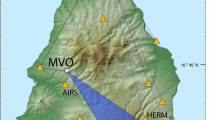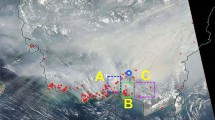Abstract
The Hekla eruption cloud on 26–27 February 2000 was the first volcanic cloud to be continuously and completely monitored advecting above Iceland, using the C-band weather radar near the Keflavík international airport. Real-time radar observations of the onset, advection, and waning of the eruption cloud were studied using time series of PPI (plan-position indicator) radar images, including VMI normal, Echotop, and Cappi level 2 displays. The reflectivity of the entire volcanic cloud ranges from 0 to >60 dBz. The eruption column above the vent is essentially characterised by VMI normal and Cappi level 2 values, >30 dBz, due to the dominant influence of lapilli and ash (tephra) on the overall reflected signal. The cloud generated by the column was advected downwind to the north-northeast. It is characterised by values between 0 and 30 dBz, and the persistence of these reflections likely result from continuing water condensation and freezing on ash particles. Echotop radar images of the eruption onset document a rapid ascent of the plume head with a mean velocity of ~30 to 50 m s−1, before it reached an altitude of ~11–12 km. The evolution of the reflected cloud was studied from the area change in pixels of its highly reflected portions, >30 dBz, and tied to recorded volcanic tremor amplitudes. The synchronous initial variation of both radar and seismic signals documents the abrupt increase in tephra emission and magma discharge rate from 18:20 to 19:00 UTC on 26 February. From 19:00 the >45 dBz and 30–45 dBz portions of the reflected cloud decrease and disappear at about 7 and 10.5 h, respectively, after the eruption began, indicating the end of the decaying explosive phase. The advection and extent of the reflected eruption cloud were compared with eyewitness accounts of tephra fall onset and the measured mass of tephra deposited on the ground during the first 12 h. Differences in the deposit map and volcanic cloud radar map are due to the fact that the greater part of the deposit originates by fallout off the column margins and from the base of the cloud followed by advection of falling particle in lower level winds.












Similar content being viewed by others
References
Adams RJ, Perger WF, Rose WI, Kostinski A (1996) Measurements of the complex dielectric constant of volcanic ash from 4 to 19 GHz. J Geophys Res 101:8175–8185
Águstsson K, Stefánsson R, Linde AT, Einarsson P, Sacks IS, Gudmundsson GB, Thorbjarnardóttir B (2000) Successful prediction and warning of the 2000 eruption of Hekla based on seismicity and strain changes. In: Proc AGU 2000 Fall Meeting, Eos 81, F1337, Abstract.
Árnason SG (2002) Heklugosid 2000: Kornastaerd, berggerd og kornalögun gjóskunnar (in Icelandic) (The Hekla 2000 eruption: grain size, composition and shape of ash particles). BSc Thesis, University of Iceland, 81 pp
Cantor R (1998) Complete avoidance of volcanic ash is the only procedure that guarantees flight safety. ICAO J 53:18–19
Carey SN, Bursik M (2000) Volcanic plumes. In: Sigurdsson H, Houghton B, McNutt S, Rymer H, Stix J (eds) Encyclopedia of volcanoes. Academic Press, San Diego, pp 527–544
Carey SN, Sigurdsson H (1982) Transport and deposition of distal tephra from the May 18, 1980 Mount St. Helens. J Geophys Res: 87:7061–7072
Ernst GGJ (1997) Dynamics of sediment-laden plumes. PhD Thesis, Department of Earth Sciences, University of Bristol, 223 pp
Ernst GGJ, Davis JP, Sparks RSJ (1994) Bifurcation of volcanic plumes in a crosswind. Bull Volcanol 56:159–169
Ernst GGJ, Sparks RSJ, Carey SN, Bursik MI (1996) Sedimentation from turbulent jets and plumes. J Geophys Res 101:5575–5589
Giggenbach WF, Garcia PN, Londoño CA, Rodriguez VL, Rojas GN, Calvache VML (1990) The chemistry of fumarolic vapor and thermal spring discharges from the Nevado del Ruiz volcanic-magmatic-hydrothermal system. J Volcanol Geotherm Res 42:13–40
Graedel TE, Crutzen PJ (1993) Atmospheric change: an earth system perspective. Freeman, New York, 446 pp
Grindle TJ, Burcham FW (2002) Even minor volcanic ash encounters can cause major damage to aircraft. ICAO J 2:12–30
Grönvold K, Larsen G, Einarsson P, Thórarinsson S, Saemundsson K (1983) The Hekla eruption 1980–1981. Bull Volcanol 46:349–363
Haraldsson KÖ (2001) Heklugosid 2000—Dreifing gjósku frá fyrsta gosdegi á landi (in Icelandic) (The Hekla 2000 eruption—distribution of ash from the first days of the eruption). BSc Thesis, University of Iceland, 34 pp
Haraldsson KÖ, Árnason SG, Larsen G, Eiríksson J (2002) The Hekla eruption of 2000—tephra fall. In: Proc 25th Nordic Geological Winter Meeting, Reykjavík, Abstract
Harris DM, Rose WI (1983) Estimating particles sizes, concentrations, and total mass of ash in volcanic clouds using weather radar. J Geophys Res 88:10969–10983
Harris DM, Rose WI, Roe R, Thompson MR (1981) Radar observations of ash eruptions. In: Lipman PW, Mulineaux DR (eds) The 1980 eruptions of Mount St. Helens, Washington. US Geol Surv Prof Pap 1250:323–333
Höskuldsson Á, Ólafsdóttir R (2002) Pyroclastic flows formed in the eruption of Hekla 2000. In: Proc 25th Nordic Geological Winter Meeting, Reykjavík, Abstract
Houze RA (1993) Cloud dynamics. Academic Press, New York, 573 pp
Karlsson KG (1997) An introduction to remote sensing in meteorology. Swedish Meteorological and Hydrological Institute, Norrköping, pp 95–129
Krohn MD, Lemon LR, Perry J (1995) WSR-88D applications to volcanic ash detection. In: Proc 1st National NEXRAD Users Conf, Norman, Oklahoma, 11–15 Oct 1994
Lacasse C (2001) Influence of climate variability on the atmospheric transport of Icelandic tephra in the subpolar North Atlantic. Global Plan Change 29:31–55
Lacasse C, Thomas LE, Björnsson H, Gudmundsson MT, Gudmundsson H (2002) Potential hazards to Great Britain from major explosive eruptions: a cross-disciplinary study of the subglacial Katla volcano (S. Iceland). In: Proc Chapman Conf on Volcanism and the Earth’s Atmosphere, Abstract, p 41
Larsen G (2000) Holocene eruptions within the Katla volcanic system, south Iceland: characteristics and environmental impact. Jökull 49:1–28
Larsen G, Vilmundardóttir EG, Thorkelsson B (1992) Heklugosid 1991: Gjóskufallid og gjósskulagid frá fyrsta degi gossins (in Icelandic) (The 1991 Hekla eruption: ash fall and ash layer from the first days of the eruption). Náttúrufraedinngurinn 61(3–4):159–176
McNutt SR (1994a) Volcanic tremor amplitude correlated with eruption explosivity and its potential use in determining ash hazards to aviation. In: Proc 1st Int Symp on Volcanic Ash and Aviation Safety. US Geol Surv Bull 2047:377–385
McNutt SR (1994b) Volcanic tremor amplitude correlated with the Volcanic Explosivity Index and its potential use in determining ash hazards to aviation. Acta Vulcanol 5:193–196
McNutt SR, Tytgat GC, Power JA (1995) Preliminary analyses of volcanic tremor associated with 1992 eruptions of Crater Peak, Mount Spurr, Alaska. US Geol Surv 2139:161–178
Morton B, Taylor GI, Turner JS (1956) Turbulent gravitational convection from maintained and instantaneous source. Proc R Soc Ser A 234:1–23
Ólafsdóttir R, Höskuldsson Á, Grönvold K (2002) The evolution of the lava flow from Hekla eruption 2000. In: Proc 25th Nordic Geological Winter Meeting, Reykjavík, Abstract
Pieri D, Ma C, Simpson JJ, Hufford G, Grindle T, Grove C (2002) Analyses of in-situ airborne volcanic ash from the February 2000 eruption of Hekla volcano, Iceland. Geophys Res Lett 29(16)
Probert-Jones JR (1962) The radar equation in meteorology. Quat J R Met Soc 88:485–495
Rinehart R (1991) Radar for meteorologists, 2nd edn. Department of Atmospheric Sciences, University of North Dakota, Grand Forks, 334 pp
Rose WI, Kostinski AB (1994) Radar remote sensing of volcanic clouds. In: Proc 1st Int Symp on Volcanic Ash and Aviation Safety. US Geol Surv Bull 2047:391–396
Rose WI, Kostinski AB, Kelley L (1995a) Real-rime C-band radar observations of 1992 eruption clouds from Crater Peak, Mount Spurr volcano, Alaska. US Geol Surv Bull 2139:19–26
Rose WI, Delene DJ, Schneider DJ, Bluth GJS, Krueger AJ, Sprod I, McKee C, Davies HL, Ernst GGJ (1995b) Ice in the Rabaul eruption cloud: implications for volcano hazard and atmospheric effects. Nature 375:477–479
Rose WI, Bluth GJ, Watson IM, Yu T, Gu Y (2001a) Hekla’s February 26, 2000 eruption as seen and measured from space using MODIS, TOMS and AVHRR. In: Proc AGU 2001 Fall Meeting, Eos 82, F1355, Abstract
Rose WI, Bluth GJ, Schneider DJ, Ernst GGJ, Riley CM, Henderson LJ, McGimsey RG (2001b) Observations of 1992 Crater Peak/Spurr volcanic clouds in their first few days of atmospheric residence. J Geol 109:677–694
Rose WI, Gu Y, Watson IM, Yu T, Bluth GJS, Prata AJ, Krueger AJ, Krotkov N, Carn S, Fromm MD, Hundon DE, Viggiano AA, Miller TM, Ballentin JO, Ernst GGJ, Reeves JM, Wilson C, Anderson BE (2003) The February–March 2000 eruption of Hekla, Iceland, from a satellite perspective. In: Robock A, Oppenheimer C (eds) Volcanism and the earth atmosphere. AGU Geophys Monogr (in press)
Soosalu H, Einarsson P (2002) Earthquake activity related to the 1991 eruption of the Hekla volcano, Iceland. Bull Volcanol 63:536–544
Soosalu H, Einarsson P, Thorbjarnardóttir BS (2002) Volcanic tremor related to the 2000 Hekla eruption. In: Proc Geol Soc Iceland, Spring Meeting, Abstract
Soosalu H, Einarsson P, Jakobsdóttir S (2003) Volcanic tremor related to the 1991 eruption of the Hekla volcano, Iceland. Bull Volcanol 65:562–577
Sparks RSJ, Bursik, MI, Carey SN, Gilbert JS, Glaze LS, Sigurdsson H, Woods AW (1997) Volcanic plumes. Wiley, Chichester, 574 pp
Stefánsson R, Bödvarsson R, Slunga R, Einarsson P, Jakobsdóttir S, Bungum H, Gregersen S, Havskov J, Hjelme J, Korhonen H (1993) Earthquake prediction research in the South Iceland Seismic Zone and the SIL project. Bull Seismol Soc Am 83:696–716
Sveinbjörnsson M (2001) Volcanic eruptions in Iceland: potential hazards and aviation safety. MSc Thesis, University of Iceland, 71 pp
Textor C, Graf H-F, Herzog M, Oberhuber JM, Rose WI, Ernst GGJ (2003a) Volcanic particles in explosive eruption columns. Part I: parameterisation of ash aggregation. J Volcanol Geotherm Res (in press)
Textor C, Graf H-F, Herzog M, Oberhuber JM, Rose WI, Ernst GGJ (2003b) Hydrometeor-ash particle growth in volcanic eruption column. Part II: numerical experiments. J Volcanol Geotherm Res (in press)
Thórarinsson S (1954) The tephra fall from Hekla on March 29th 1947. The eruption of Hekla 1947–1948. Soc Sci Islandica 2(3):68
Thórdarson Th, Self S (2003) Atmospheric and environmental effects of the 1783–1784 Laki eruption: a review and reassessment. J Geophys Res 108(D1)
Wilson L (1972) Explosive volcanic eruptions—II: the atmospheric trajectories of pyroclasts. Geophys J R Astron Soc 30:381–392
Acknowledgements
The authors would like to thank the Icelandic Meteorological Office and the Science Institute at the University of Iceland for their support, and especially Philippe Crochet, Hreinn Hjartarson, Hrafn Gudmundsson, Erik Sturkell, Kjartan Haraldsson, and Stefán Árnason for fruitful discussions and for giving access to unpublished data. The Icelandic Civil Aviation Administration provided very constructive comments throughout the study. C.L.’s research work was supported by internal funds from the Open University. G.G.J.E. acknowledges the support of the Fondation Belge de la Vocation, the Belgian NSF (FWO-Vlaanderen), and Ghent colleagues. Peter Mouginis-Mark, David Pieri, and an anonymous reviewer are acknowledged for thorough reviews of the manuscript.
Author information
Authors and Affiliations
Corresponding author
Additional information
Editorial responsibility: P. Mouginis-Mark
Rights and permissions
About this article
Cite this article
Lacasse, C., Karlsdóttir, S., Larsen, G. et al. Weather radar observations of the Hekla 2000 eruption cloud, Iceland. Bull Volcanol 66, 457–473 (2004). https://doi.org/10.1007/s00445-003-0329-3
Received:
Accepted:
Published:
Issue Date:
DOI: https://doi.org/10.1007/s00445-003-0329-3




